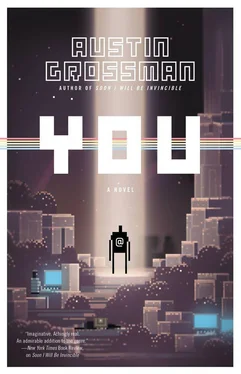You realize the planets form a pattern, a shitty, useless zodiacal configuration, as jumbled and abstract as any other constellation. From one angle it might be a three-masted galleon; from another, a giraffe. From a third it looks very, very much like a giant hand giving you the finger. What would Lorac say? The real one, the wizard, but he doesn’t seem to be around. Or Karoly, either.
The tracking device points you up and out of the galactic disk, a line that seems pointless, bound for the edge of the universe. But at the far reach, far, far beyond the galaxy proper, barely detectable on Ley-R4’s telescopes, there is a dim, dying star.
“You’re telling me the planet is too far to get to?”
“Even at the top of the FTL drive tech tree, using ripplewarp technology with all the trimmings, and pushing the time scale all the way up, the sixty-thousand-light-year span can be crossed no faster than exactly one hour, which is what Darren decided is the maximum attention span of a human being. It’s already thousands of times the speed of light, and they designed it so that’s all any technology can do. Which means that to travel nine point eight five yottameters—” Lisa broke off. She always had to do math in her head.
“I’m waiting,” I said. I watched her work. “Just use a calculator.”
“Shut up.” She mouthed a word repeatedly while she thought. It looked like maybe she was saying, stupid you, stupid you, stupid you. Then, finally: “Sixty thousand light-years in an hour, and a yottameter is a hundred and five million light-years, sort of, so vaguely, like, seven hundred twenty days minimum.”
“So we’ll get there, and meanwhile we’ll hoard glass beads to be ready for the bold posteconomic era.”
“I think in the game mechanics you have to carry fuel, too,” said Matt. “You couldn’t do it anyway.”
“I hate this game,” I said. “I hate this game so much.”
We went back to the message boards. Surely someone had been there, or someplace similar. But there was no mention of it; no strategic or narrative reason even to look in that direction.
Matt called me over, a few hours later. “I think I’ve got it. The Big Bump.”
“Tell me.”
“A bug. It’s mentioned only three times, in three reports, widely separated. All three times, a starship running on reactive drive was in midbattle when, in an instant, it found itself halfway across the galaxy. Usually in pieces, but it had traveled faster than the sim said it could—much, much faster. But no one knows how to trigger it.”
It stumped us for days, until one day Lisa plunked herself down in a spare Aeron chair and wheeled herself up to me. Neither of us had bathed in a few days, but it didn’t matter.
“I think I have a thing to try, anyway.”
“Tell me.”
“I’ve always hated reactive drive. It’s the worst thing in the game.”
“I thought players loved it.”
Reactive drive was a tech you discovered when you got maybe two-thirds of the way through the game. It let you start and stop spaceships on a dime, just zero out any velocity and park it, motionless. Or start it up the same way. It was a good trick in a dogfight, but that was about the last time when individual ship-to-ship combat meant anything. After that, things like antimatter clouds and starbusters came into play.
“Players do, yeah,” she said. “It’s for players who like games and who are too lazy to make orbital mechanics work. That kind of start-stop bullshit is how people are used to things moving in games. It’s intuitive, it’s point-and-click. It’s clean.”
I felt a little guilty. I always hated how in Asteroids, once you fired your jets it was almost impossible to bring your ship to a dead stop again. Realistic, but annoying.
“Yeah. No one but you really likes calculating fuel burns. It’s a pain.”
“Right. But you know who else hates reactive drive? The physics simulation module. The physics system hates it. It spends all day making things behave all proper and Newtonian, and Darren writes this spec saying, ‘Okay, this tech makes ships start and stop instantaneously, because that’s fun.’ And it is, but it’s nonsense physics. In the real world, if you want to decelerate, you have an equal and opposite force, and you stop, over some distance that is not zero. It may be a millimeter, but it is definitely not zero.”
“Who cares? Doesn’t the programmer just write, um, ‘velocity equals zero’ and leave it at that?”
“No! No!” she said, her voice cracking a little. “Sorry, really need to sleep more. But no. The point of a physics model is that it takes over all that stuff for you. Where stuff is, how fast it’s going and in what direction, what’s touching what. You’ve put it in charge, and if you go in and micromanage it starts to get confused and snappish and doesn’t know where to put things. Plus you can’t even always do it.” She did a gesture, blinking and waving both hands as if to disperse the very thought.
“So reactive drive is part of the physics bug?”
“You call it a bug, I call it physics justice. Just listen. I tried to think how reactive drive works at all. So I went to the actual code, which is by—” She glanced around and whispered, “Todd,” then went on. “It’s a total mess, a lot of different ideas commented out, a lot of just ‘fuckety-fuck this code’–type comments. Bottom line, they can’t just set it to zero, and there’s a limit to how much they can just drop the kinetic energy of these starships right out of the universe. I mean, it’s a mile-long chunk of titanium, potentially, up among the high-end Angel-class ships. So they ended up with this horrible, horrible hackery. Just for an instant, they set the starship’s mass to a number so small it’s as close to zero as the physics universe will tolerate. It’s a lot easier to bring it to a dead stop when it weighs about as much as a neutrino. But just for one tick of the clock. Then it’s back up to its usual gigaton self, and hopefully no one notices.”
“So… fine?” I offered.
“It’s not fine! That’s the thing. For one cycle of the simulation, its mass is near zero. That means—” She stopped altogether and wrote on my whiteboard F = MA. “Okay. God. Force equals mass times acceleration, right?”
“Okay, okay, yes. I’m not totally hopeless,” I said.
“You’d better not be. Reactive drive wants mass to be small, so force is small. But then if mass is just about zero, what if we’re trying to work out acceleration?”
She wrote another equation: F/M = A.
“Acceleration. Now we’re figuring out what force divided by mass is. So if force is anything reasonable and mass is virtually zero, anything divided by zero is…”
“Infinity.”
“Yes! Acceleration is infinite!” she said. She actually struck my desk with her fist. “And that’s what the Big Bump is. Those ships got hit exactly when they weighed nearly nothing. And boom, they went right to nearly infinite velocity. Nothing to stop it.”
“Wait… did you just invent hyperdrive?”
“I call it Enhanced Reactive Travel, but yes, I did. And you’re welcome.”
You remember the days when you were working so hard to figure out how to act normal and attractive, so hard it was killing you, so hard you moved to Portland. How did you get tricked into believing that that was all there was?
For all that I understood Lisa’s equation, I had no idea how to make it happen in a game. I called Matt and Don and had her explain it to them.
We set up in the conference room with the amp-up demo machine and hooked up the projection screen for Matt to use. This was, after all, what he used to do—re-create the precise, heartbreakingly specific set of conditions that will strike an apparently beautiful simulation along its hidden logical fault line and tumble the world into nonsense again.
Читать дальше





![Ally Carter - [Gallagher Girls 01] I'd Tell You I Love You But Then I'd Have to Kill You](/books/262179/ally-carter-gallagher-girls-01-i-d-tell-you-i-lo-thumb.webp)






